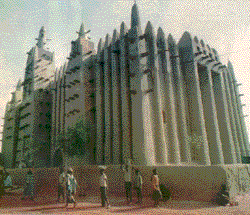Arthur
Timothy, Annette Fisher and the Society of Black Architects
Building Black Community
Turning plans into reality is Architect Arthur Timothy's
profession. But giving new life to communities and nurturing
the talents of black youth is his proudest goal.

Arthur Timothy
Timothy, who has offices in London, is the son of professional
parents - Adeline Dove of Ghana and Bankole Timothy of
Sierra Leone, one-time editor of the Daily Graphic in Accra. "I
went to public school in England and had all the advantages
of a good education, and our practice is thriving," he
says.
Meeting needs
What excites Timothy most is "making a difference
where it counts for black people". This means putting
his skills to work improving inner city neighbourhoods.
It is a crucial service for black communities whose needs
are not met by public and market-led renewal schemes.
But establishing a reputation among the 30,000 architects
in Britain is not easy, he says. Within a profession which
is middle-class and white "many black architects have
been denied good commissions and opportunities to broaden
their skills". Prejudice also plays a part and "local
authorities and property developers can be the worst culprits",
he says.
Overcoming these barriers is a major task. "We need
more black architects and greater public awareness of their
skills", says Timothy. It is no surprise, then, to
learn that these are the aims of the 70-member Society
of Black Architects (SOBA) of which forty are students.
His views are shared by colleagues - among them Kwasi Boateng,
SOBA chairman, Chris Nasah of Cameroon, a partner in Knak
Design, and Wilfred Achille of Trinidadian background who
is partner in Mode 1 architects.
Black architects
The society is determined to foster more black talent in
architecture. Achille recalls that growing up in a Trinidadian
family in London in the fifties "we didn't have
black role models in the world of architecture and design".
Now, SOBA members help guide students and young professionals
through the difficult early stages of their careers.
Timothy, who tutored the late Stephen Lawrence in urban
design, has almost single-handedly placed architectural
training for blacks on the agenda of major British institutions.
Through his efforts as chair of the Lawrence charity, the
Royal Institute of British Architects and the Architectural
Association School have launched awards and scholarships
for black students.
Breakthrough

Annette Fisher
Now, a unique breakthrough has been made. Annette Fisher,
a registered architect with 17 years work in the USA,
Africa and the UK has become the first black woman elected
to
the prestigious RIBA council. Ms. Fisher, of Nigerian
parents, was born in Scotland where she completed her
five-year
architectural studies in 1983. A SOBA member, she specialises
in commercial property development and has experience
formulating business plans for inner city job creation
projects.
Above and beyond her qualifications, Ms. Fisher's pre-election
statement "Why Choose Me?" underscored her deep
commitment to change. "I believe that through having
more people like us in main stream architecture we can
remove the glass ceiling that women and minority architects
face in the work place. Attitudes within the construction
industry need to change as we move into the 21st century," she
said.
Based on her experiences she says "The developers
who fund the inner city regeneration projects often perceive
gentrification as the supplanting of these communities,
ignoring the fact that every one wants and is entitled
to live in a good neighbourhood. Creating them is not just
about new buildings, but new attitudes, jobs, and a new
social awareness allowing people to be responsible for
and play a part in reforming their own communities."
Something special
Many black architects of African Caribbean backgrounds
are also convinced they can add something special to
a society and profession that often ignores "non-western" ideas.
They can "bring a whole range of cultural references
to bear on their work," says the Cameroonian Chris
Nasah speaking to The Guardian March 29, "rather
than just fit in with the established flow."
These special qualities stem from fruitful cultural interaction
across three continents of the African Diaspora. "Our
biggest commission," says Arthur Timothy, "is
to design four universities devoted to business studies
and funded by the performer Michael Jackson with Nelson
Mandela's backing in Cape Town, Accra, Tunis and Nairobi.
Great projects - fantastic projects - but very black projects."
Rich heritage
In a period when more Black Britons are rediscovering
their roots, black architects are uniquely placed.
SOBA, founded
some ten years ago, can highlight Black contributions
to world architecture by organising workshops, conferences
and projects for students, practitioners and community
groups. It can encourage exploration of the rich heritage
of architectural styles, cultures and materials - from
the monuments of African master builders to the small-scale
efforts today of self-help black communities in the
Caribbean, the Americas and Africa.
Black architects have found a niche in the architectural
marketplace. Some may not like doing what others call "ghetto
projects". But their accomplishments provide a solid
base from which to move forward.
Undoubtedly, black architects will face uncomfortable
dilemmas. "Often people don't want to be defined by
the colour of their skin as by their skills. On the one
hand we just want to be architects like any other; on the
other we need to talk together and encourage each other," says
Arthur Timothy.
In resolving these dilemmas, individually and in unison,
black architects are beginning to understand some elementary
requirements of 'being black for black people' in western
societies. The test of their abilities is not a career-long
wait for grudging acceptance. Nor is it a lifetime of scavenging
for crumbs of opportunity from the tables of patricians,
policy makers and developers. Black architects have a more
elevated historic task: that of building and re-building
healthy and prosperous Black Communities in line with their
rich heritage.

The Mosque at Jenne
Arthur Timothy's Work
Arthur Timothy attended Queen's College Taunton and Sheffield
University, where he gained a master's degree in architecture
in 1981. His firm, Timothy Associates, has developed considerable
expertise in housing and development in urban renewal areas.
Described below are his early projects at Deptford 1988
and Trundleys Road 1989, and his current projects in Lewisham
and Stonebridge housing estate. Timothy's Africa Lake project
in Accra, Ghana is also of interest.
Deptford urban renewal
Deptford High Street/Broadway site. Design scheme for 49
flats, 10 workshops, 2 pub and a library. London, 1988.
Project Value: £3 million. The design, undertaken
on behalf of Lovell Urban Renewal, was judged the best
development prospect for the site by the Lewisham Borough
Council planning committee
Trundleys Road
A proposal providing 2/3 bedroom houses, offices and 6
flats on a prominent but restricted corner site. London,
1989. Project Value: £1 million.
Lewisham 2000 (Winning Design Entry)
Multicultural arts complex for a 12-screen cinema/retail
centre. Lewisham, London, 1996. Project Value: £8
million.
Stonebridge Estate social housing
Design phase of 22 flats and 10 houses. North, London,
1999. Project Value: £2.2 million.
Africa Lake (Phase 1-Design and documentation)
200 bedrooms hotel, sports centre, commercial centre, apartments.
Accra, Ghana, 1995. Project Value: £45 million.
© Copyright 1997-2005 Chronicle World
We thank http://www.chronicleworld.org for
using this article from their archive. Visit their site!
|




